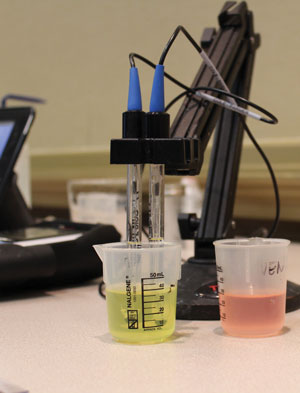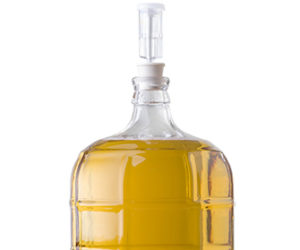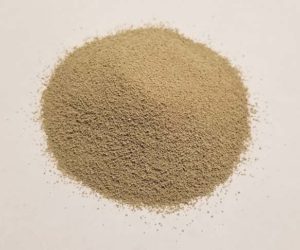A note from the Wine Wiz: I decided to answer the below question in a slightly different format, because it was so multi-part and because it might be easier for you to read through that way as well. I’ve highlighted each of his questions in orange, with my response below each question in black type. I’d been able to help Hunter Nolen out with a Viognier question he had earlier, and he came back with a question about his red wine and malolactic fermentation (MLF). Below is a slightly expanded version of our original correspondence. There’s nothing I love more than to know my advice helped someone through a rough patch and helped them achieve what they were looking for — a tasty wine in which they can take pride and pleasure.
Thanks again for your help in saving my high-sugar Viognier a couple of years ago. It is all gone now! I grow Syrah, Tempranillo, and Mourvèdre. In the Texas Hill Country the grapes “cry uncle” around the third week of July and I have to harvest or they will abruptly collapse in the relentless 100 °F (38 °C)+ heat. Because of the abruptness of collapse, I have learned to pick early rather than late because early means usable grapes and late means mush! I therefore end up picking on the third weekend in July when I can generally count on little rot, decent maturity, and available family and friends to help.
Also, due to the daytime heat and little relief through the night, I generally wind up with high pH. This year my pH came in at what I consider quite acidic for my vineyard (3.4), while my sugar was light (about 21 °Brix). I therefore chaptalized to about 24 °Brix before pitching my yeast. After fermentation, my pH had risen to right around 3.7, and I get a little nervous about long-term stability above 3.65. My inclination has always been to acidulate to around 3.65, which makes me more comfortable and usually does not tarten up the wine too terribly much.
I am generally inclined to conduct MLF on my red wine even though the pH is on the high side. I like to know my wine is stable for the long run, and generally favor the idea of converting my malic acid to lactic acid for flavor and mouthfeel reasons. But, I have seen some literature that suggests foregoing MLF on high-pH wines. This year I have done no acidulation yet and started my MLF culture going on the pH 3.7 wine. Finally, after MLF this year I fully expect my pH to be up around 3.8.
OK, enough of the chatter. My questions below in orange
Hunter Nolen
New Braunfels, Texas
Q
In the above situation, what do you suggest I do? Do you agree that I should conduct MLF on my wines considering their high-pH characteristics?
A
First off, glad your Viognier got better! That’s awesome you’re doing both reds and whites, it’s fun to try a lot of different kinds of wines. Well, I hear you about heat — I grow some grapes in Paso Robles region of California and we definitely have high pH problems as it gets so hot. For your Texan reds, even though the pH is creeping up at 3.7 post-primary fermentation, I still encourage MLF in this situation because aging red wines are always a risk for in-barrel or in-bottle MLF, both of which can cause off aromas and flavors and can ruin your wine.
Q
What is your absolute top-end pH that you personally will not go above in a finished red wine?

A
I don’t like to go above 3.85 at bottling, though that means you need to really have great sanitation, no headspace, and minimize oxygen exposure. It’s also not a safe pH to be storing wine in barrels for two years. You could do what some high-end Napa Valley producers do — store their wine for long term aging at 3.55–3.6 pH, then add carbonate about a month before bottling to adjust pH up to around 3.8-ish. If you sterile filter and bottle with free SO2 of around 28 ppm or so, you’ll have little chance of anything cropping up in the bottle.
Q
And, if you end up with a wine around pH 3.8 that tastes good as-is, what do you consider to be top-end [sulfite]? Sulfite efficacy charts I refer to from winemakermag.com/sulfitecalculator indicates I need around 100 mg/L FSO2 in order to be protective but that has its downside on aroma, flavor, and color. These are my WWAD questions (What would Alison do)?
A
Hahaha, you’re funny. Again, you could store at a lower pH so you wouldn’t have to use so much SO2 over the wine’s lifetime, then raise the pH right before bottling. Storing long-term at 3.8 pH really isn’t safe and I would definitely go down to a 3.6–3.65. A pH 3.8 for bottling, as I mention above, isn’t unusual for big reds — and then I wouldn’t bottle with more than 30 ppm FSO2. I know it’s not correct from a molecular SO2 level, but seriously, it’s really difficult to achieve the holy grail of 0.8 molecular SO2, (or 0.5 recommended for red wines) as the charts would have you try for and not have your wine’s flavor and aroma suffer. So I (and most other commercial winemakers I know) would never even try for this level. We angle for that delicate balance between antioxidant and microbial protection for our wines and overall quality. This is why great sanitation, as well as having a handle on what kinds of microbes live in your cellar and wines while aging, can be really important information to have. It’s also why filtering finished wines before bottling isn’t a bad idea. If you filter your wine it’ll allow you to have slightly lower molecular SO2 levels over a wine’s lifetime but especially right before bottling.
Q
I tend to get a lot of precipitation of crystals in my whites, especially when I adjust acidity, either by adding my acid or my correcting with bicarbonate if the juice is too acidic . . . but I’m not sure. Any ideas on how to minimize the precipitation? My gut sense tells me to stop messing around with the acidity, but it’s a hard decision when the initial pH of some Rieslings or Sauvignon Blancs are in the 2.9 range.
Maggie
via email
A
Indeed, a pH of 2.9 is really low, even for a Sauvignon Blanc, and I think I would definitely de-acidify in that case. With deacidification you’ll always get some kind of precipitation; that’s totally normal. You just want to make sure it’s precipitating in your bulk-aging container (keg, carboy, drum, etc.) and not in the bottle! Who wants to strain crystals between their teeth when drinking a white wine?
Adjusting acidity is critical and so precipitation of solids just has to be put up with — though in whites you always want to make sure you cold stabilize in some way to retard precipitation in bottle. For home winemakers this can sometimes be hard to do the old-fashioned way, i.e. get the wine below 32 °F (0 °C) and then seed with potassium bitartrate crystals (cream of tartar) to force a precipitation. The wine is then filtered while cold to remove the solid crystals. As you might imagine, this can be really difficult for home winemakers to achieve.
If you just make a small amount of wine and have a spare “beer fridge” (my husband homebrews) like I do in my garage, pop your keg or carboy in there for a week or two. Even chilling to fridge temperature will help precipitate out excess tartrates in the wine though it may not take care of any and all crystals that might precipitate over time.
However, there is a new, legal, and safe wine additive that we all can use now to cold stabilize wines, without having to chill them down. Carboxy methylcellulose (CMC) is a new wine additive that basically forms colloids to help prevent crystallization in final bottled wine. All you do is add 1 mL/L to finished filtered white wines right before bottling. Well, to be more exact, to find out if your wine is a candidate for CMC (the wine has to be reasonably “unstable” as opposed to “very unstable”), you can send a sample to ETS Labs (www.etslabs.com) for an analysis called a “DITS” (Degree of Tartrate Instability). If the “Rate of Electrodialysis” is <24%, then your wine is a candidate for CMC use and you add 1 mL/L after final filtration, right before bottling. If your result is >24%, then you can try chilling your wine a bit, and see if that precipitates out some tartrates. Try re-testing for DITS after a few weeks of lower temperatures. For all of the wines I’ve bottled over the last five years, I’ve only ever had one wine not pass the DITS test, so it’s very likely that your wine will be fine. If you’d rather not pay for the DITS test (and hey, it’s home winemaking after all) you could probably get away with foregoing it.
Note that CMC does NOT work in reds or rosés, only whites. Most wine supply houses carry one of these products, for example the one sold by Laffort is called Celstab. It’s truly a game changer for home winemakers who want to cold stabilize their wines. No more worry about getting the wine cold enough and doing fiddly additions and filtrations.
Q
Just for fun, I made a vegetable wine out of cucumbers. My problem now is that the specific gravity is at 0.990, but the “must” is still actively bubbling in a carboy . . . like a bubble every 5 seconds. It tastes dry as well. I’ve NEVER seen this happen before, with the hundreds of grape wines that I’ve made. Would there be that much dissolved CO2? Should I just rack and vigorously stir the wine?
Lee
via email
A
Well, according to specific gravity, your cucumber wine (sounds refreshing) is dry. For RS-dry (residual sugar dry) you want to look for an SG of 0.992 and 0.996 on your hydrometer. If your wine is dry, with no sugar left to ferment, and it’s still actively producing CO2, then the next thing I’d wonder about is this: Is there another microbe in there eating something and producing CO2?
Since I’m not too familiar with the chemical makeup of cucumbers, I did a little quick research and lo and behold, it turns out cucumbers are chock full of malic acid. And what common wine microbe eats malic acid and pumps out carbon dioxide gas? How about your friend and mine, malolactic bacteria? These guys are often purposely inoculated into wines for this specific purpose — to render wines more microbially-stable during storage and bottling, as well as to naturally de-acidify them. Typical of these bacteria are Oenococcus oeni and various species of Lactobacillus and Pediococcus.
If I had to put money on it I’d wager you’ve got a spontaneous secondary fermentation happening and you’ve got some bacteria in there that are actively metabolizing your wine’s malic acid and spitting out lactic acid and carbon dioxide, along with possibly some other flavor and aroma compounds.
Adjusting acidity is critical and so precipitation of solids just has to be put up with . . .
If you want to stop the malolactic fermentation from happening, i.e. if you like the acid balance and don’t want to risk any lactic acid bacteria off-flavors, you may want to add sulfur dioxide in the form of potassium metabisulfite powder, a Campden tablet, or liquid SO2 solution, whichever method you use. You could also chill the wine down — is it possible to store it in a fridge so you can retard the fermentation?
If you want to de-acidify a little bit and don’t mind the aromas and flavors you’re getting, you could always let this second fermentation go to completion. To test for completion, you can send a sample off to a wine lab or you could go low-tech and wait for these bubbles to subside before you rack and add SO2 (sulfur dioxide). You could also add SO2, chill, and then filter if you are able. Not sure about you, but my gut tells me that you’ll make a better cucumber wine if you don’t let it go through malolactic fermentation (MLF). Basically, MLF, while it can de-acidify a wine, also produces a wide variety of aromas, some of which might not match the delicate aromas of your raw material. I’m not sure how well diacetyl (butter) would go with cucumbers in a wine. I’d shoot for fresh and crisp and not let any of the sometimes-weird secondary aromas creep in.
If you just add SO2 and leave residual malic acid in your wine, you’ll have to be really vigilant on maintaining a free SO2 of around 30 ppm or so (more, if the pH of your wine is higher than 3.5-ish), to retard this fermentation through aging and into the bottle. Alternately, you could sterile filter your wine to exclude the bacteria.
A cucumber/veggie wine sounds very refreshing on a summer day! Way different than I make in California but maybe someone somewhere will make something cool for the tasting room one of these days . . .
Do you have a question for the Wine Wizard? Email us at [email protected]






